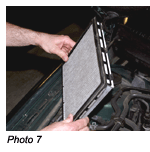They call it the “hidden filter” because many motorists don’t realize their vehicles have separate air filters for the passenger compartments. Cabin air filters first appeared back in the mid-1980s. The earliest applications were on Audi and other European makes. Today, about 80% of all new import and domestic vehicles have a cabin air filter — or a slot where one can be installed.
Cabin air filters are put there for the health of the vehicle’s occupants. The filter can trap pollen, dust, smoke and other pollutants that would otherwise enter the vehicle and possibly irritate the nose and lungs of the driver and passengers.
Most of these filters are highly efficient and have electrostatically charged fibers that do an excellent job of trapping even the smallest particles (down to 0.3 microns!). A human hair, by comparison, is about 40 to 70 microns across. Most cabin air filters will stop 100% of all particles that are 3 microns or larger in size and 95% to 99% of particles in the 1 to 3 micron size range.
Some cabin air filters also trap odors and are called “combination” filters. These type of filters have an extra layer of activated carbon that reacts with odors and other airborne pollutants to neutralize them before they become objectionable. The filters can even reduce the levels of carbon monoxide and oxides of nitrogen from the exhaust of other vehicles. The levels of these pollutants can be quite high in heavy stop-and-go traffic, and it’s not unusual for the concentration of these pollutants to be several times higher inside a vehicle than outside. Studies have shown that driver reaction times are slower when the driver is being affected by poor air quality.
Cabin air filters also prevent leaves, dirt, bugs and other debris from entering the HVAC (Heat Ventilation and Air Conditioning) system. This prevents the fan and control doors from becoming jammed with debris that could cause fan noise or affect the operation of the heater, air conditioner and defroster. Keeping the HVAC system clean also helps reduce the growth of odor-causing mold and other microbes on the A/C evaporator.
When to Replace CAFs
The recommended replacement interval for a cabin air filter depends on the type of filter (pleated paper or a combination filter with activated carbon) and the filter’s exposure to environmental pollutants.
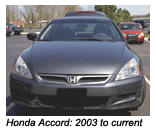 As a general rule, most cabin air filters should be changed every 20,000 to 30,000 miles — or more often depending on the size and capacity of the filter. Some vehicle manufacturers recommend replacing an odor-absorbing cabin air filter every 12,000 to 15,000 miles or once a year to keep the filter working at peak efficiency. We have found that some CAFs are recommended for replacement at 10,000 miles. Refer to the vehicle owner’s manual for specific service interval recommendations.
As a general rule, most cabin air filters should be changed every 20,000 to 30,000 miles — or more often depending on the size and capacity of the filter. Some vehicle manufacturers recommend replacing an odor-absorbing cabin air filter every 12,000 to 15,000 miles or once a year to keep the filter working at peak efficiency. We have found that some CAFs are recommended for replacement at 10,000 miles. Refer to the vehicle owner’s manual for specific service interval recommendations.
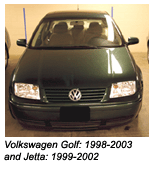 If a cabin air filter is neglected and is not changed for a long period of time, it can become clogged with dirt and debris. This will create an air restriction that can reduce airflow and the output of the heater, defroster and/or air conditioner. A complaint of poor heating or cooling, therefore, may be the result of a clogged cabin air filter that is long overdue for replacement.
If a cabin air filter is neglected and is not changed for a long period of time, it can become clogged with dirt and debris. This will create an air restriction that can reduce airflow and the output of the heater, defroster and/or air conditioner. A complaint of poor heating or cooling, therefore, may be the result of a clogged cabin air filter that is long overdue for replacement.
Where to Look
Most cabin air filters are flat panel filters, but some have unusual shapes so they will fit the HVAC inlet duct. The filter is usually located behind the glove box or at the base of the windshield in the cowl area over the HVAC inlet duct. The exact location can be found in the vehicle owner’s manual or a filter reference guide. On some applications, the filter may be in two sections to make installation easier.
Replacing a cabin air filter is fairly easy on most vehicles once its location has been determined, but on some, the glovebox or console must first be removed.
A related item your customer might want to buy would be an air freshener or some scented aerosol spray to mask smoke, animal odors or other smells. A cabin air filter can remove odors from incoming air but it won’t do anything for odors that may already be inside the vehicle. So if someone has been hauling around a wet dog or delivering pizza, it will take more than a cabin air filter change to get rid of the aromas.
The following are some CAF locations and replacement procedures for vehicles you might find in your shop.
Honda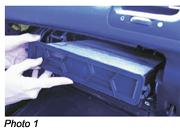 Recommended replacement interval: 10,000 miles or after 12 months
Recommended replacement interval: 10,000 miles or after 12 months
Tools needed: none
Estimated service time: 3 minutes
Location and Replacement:
Open glove compartment. Disconnect the right side of the glove compartment by unhooking stop.
Push in on the top of the glove compartment on both sides. This is to unhook the glove compartment from the dash. Allow the glove compartment unit to drop down, as shown in Photo 1.
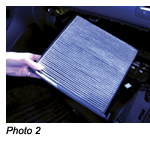
Remove the CAF frame.
Remove filter (see Photo 2) and replace with a clean CAF.
Replace CAF frame and reposition glove compartment. Reconnect the stop on the right side of the glove compartment.
Volkswagen
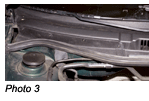 Recommended replacement interval: 10,000 miles or after 12 months
Recommended replacement interval: 10,000 miles or after 12 months
Tools needed: Phillips screwdriver
Estimated service time: 7 minutes
Location and Replacement:
Open the hood.
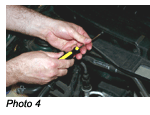
Locate and remove the weather stripping from the passenger side, as shown in Photo 3. Remove the four screws from the cabin filter cover, see Photo 4.
Remove the cover by pulling it toward front of the vehicle, see Photo 5.
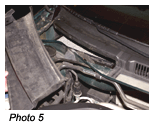
Remove the CAF and top filter housing plate by depressing the two tabs on the top of the housing plates. Lift the CAF and pull out, as in Photo 6.
Remove the used filter from the top housing plate and replace with the clean CAF. See Photo 7.
Note: Make sure to line up the four notches on the top side of the filter with the ribs on the top housing plate.
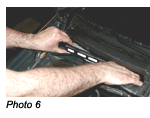
Reinstall the filter and top housing plate by pushing them down until the two tabs click into place.
Reattach the cover.
